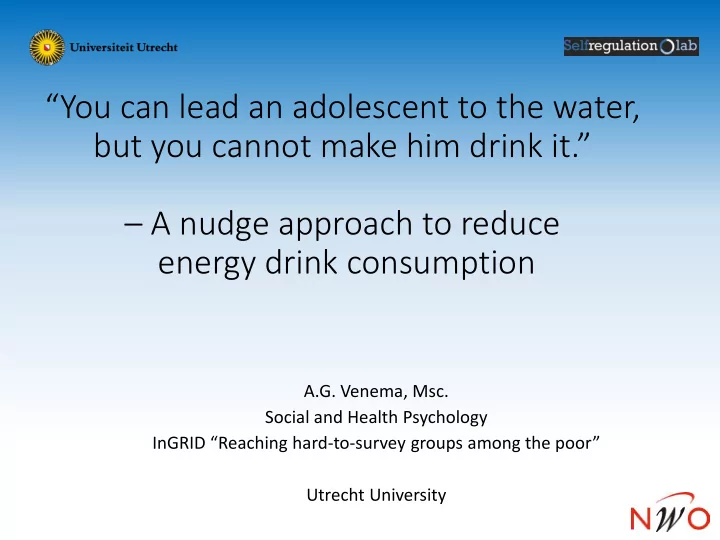

“You can lead an adolescent to the water, but you cannot make him drink it.” – A nudge approach to reduce energy drink consumption A.G. Venema, Msc. Social and Health Psychology InGRID “Reaching hard-to-survey groups among the poor” Utrecht University
A quick overview • Problem: Adolescents drink too much energy drinks during school hours. - Current interventions are not effective, nor is prohibiting. • Solution: Nudge them towards healthy beverages.
About the target group • High school- preparing for vocational education - Ethinically diverse backgrounds - In one of the poorest neighbourhoods in Utrecht - 631 pupils in 2015-2016
The problem • (Childhood) obesity Utrecht municipality population health (2014); Kenney, Gortmaker, Carter, Howe, Reiner & Cradock (2015). • Caffeine intoxication - nervousness, anxiety, mood disorders, restlessness, insomnia, gastrointestinal upset, tremors, tachycardia, psychomotor agitation American Psychiatric Association (1994); Greden (1974) • Substance dependence – withdrawal symptoms (headache, tiredness, concentration problems, nausea, muscle aches, etc.) Griffiths, et al. (1990); Juliano and Griffiths (2004)
The problem • Aggressive marketing to adolescent target group • Born in 1997 • Lots of literature on energy drinks and alcohol, but we focus on a school setting.
Interventions so far • Effective study on decreasing Sugar-sweetened beverages, supplying non-sugar beverages as replacement. Ebbeling, Feldman, Osganian, Chomitz, Ellenbogen, & Ludwig (2006) • Promoting (installation of fountains and educational programs)water drinking did not decrease soft drink consumption. Muckelbauer, Libuda, Clausen, Toschke, Reinehr, & Kersting (2009); Kenney, Gortmaker, Carter, Howe, Reiner & Cradock (2015). • Education programs and injunctive norm convesion reactance. Bem, (1991); Stok, De Ridder, De Vet, & de Wit (2005) • Therefore, subtle manner of behavioral influence is neccessary.
What is a nudge? “A nudge is a change in the choice architecture that steers people towards the best choice, without forbidding alternatives or changing their economic incentives.” - Thaler & Sunstein, 2008
Some examples
Which nudge should you select? Diagnostic approach - dr. P. Hansen
When is a nudge effective?
Proposed method: Mixed methods: Do you know of good sources on Step 1 how to set up a Start with focus group: focus group - What is the severity of energy drink consumption? meeing? - What is the perceived social norm? - What does a normal day at school look like? - What types of groups are there? - What are things that they talk about with their friends? - Attitude of parents on energy drinks. - Also all of the above questions about water. - Barriers to drinking water.
Step 2 experimental design T1 control condition T2 experimental condition – not fitting nudge (but based on literature) ~washout weeks~ T3 experimental condition – fitting nudge
Dependent variables • Questionnaire data? • Potential high non-response. • Trashcan surveillance ( counting energy drink cans)? • Cannot be traced back to individuals. • Sales data canteen? • A lot of adolescents bring drinks/food from home or supermarket. • Observations? • Difficult to do unobtrusively.
Summary • Aim of study: Compare effectiveness of 2 types of nudges on reducing energy drink consumption in favor of water consumption. Hard-to-persuade + Hard-to-interview • Question to summerschool: What is your experience with organizing focus groups? - preparation, usefullness, sample size,etc.
Follow-up study • Different target behavior (e.g. Leaving trash lying around) same approach.
Thank you for your time! a.g.venema@uu.nl www.selfregulationlab.nl
Recommend
More recommend